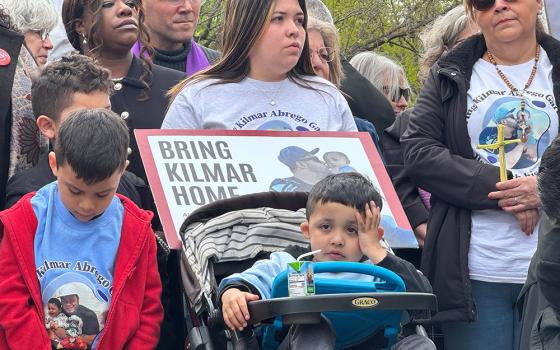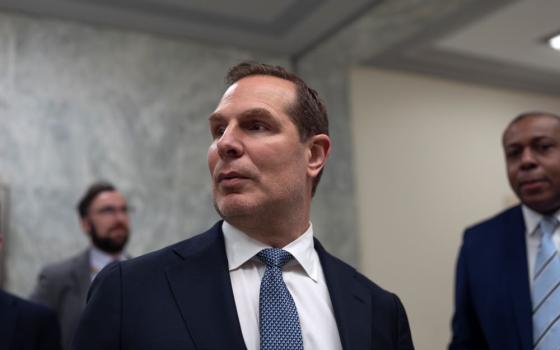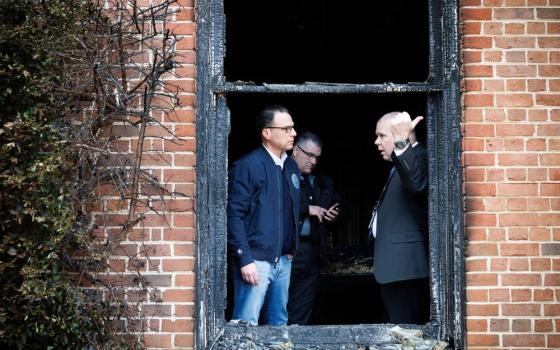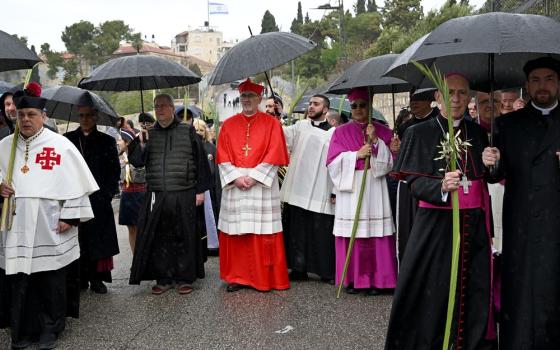Most people believe the real power in Catholicism resides with the hierarchy, and in terms of both theology and church law, that's basically right. For instance, canon law says the pope wields "supreme, full, immediate and universal" authority, and it's tough to get more sweeping than that.
One wonders, however, if an accountant would reach the same conclusion.
When it comes to the financial dimension of Catholic life, there are certainly some deep pockets out there. Just to offer a few examples:
- The University of Notre Dame, America's flagship Catholic university, has an annual budget of $1.2 billion and an endowment estimated at $7.5 billion.
- The Archdiocese of Chicago last year reported cash, investments and buildings valued at $2.472 billion.
- The Knights of Columbus has more than $85 billion of life insurance in force, with $8 billion in annual sales.
- In Rome, the Institute for the Works of Religion, known popularly (if, some say, inaccurately) as the "Vatican Bank," administers assets in excess of $6 billion.
- American Catholics drop more than $8 billion every year into the Sunday collection plate, which works out to more than $150 million a week.
- In Germany, the Catholic church netted $8.8 billion in 2010 from the national "church tax," allowing it to remain the country's largest private employer after Volkswagen.
Simply ticking off those dollar amounts, however, two points are easy to miss.
First, the vast majority of money washing through the church remains on the local level, especially the parish. In the United States, more than 90 percent of revenues collected by parishes remains there. Those funds are not centrally collected, and they're not really even centrally tracked, either by the bishops' conference or by Rome. Nobody in the Vatican could tell you how much a parish in Dubuque, Iowa, spent this month on coffee and donuts after Mass.
Second, much of the real money bypasses the hierarchy. To take the most obvious example, Catholic hospitals generate billions in revenue, well above what parishes will ever see from their collection plates. Hospitals may be sponsored by a religious order or other canonical entity, but they're usually governed by a lay board of directors and incorporated under civil, not ecclesiastical, law. The same point holds for most Catholic colleges and universities.
If you're looking for the real moguls and tycoons in the church, in other words, they're not to be found among the bishops.
Let's crunch some numbers to flesh out these observations.
Based on data from the Center for Applied Research in the Apostolate, average annual parish revenue in the United States is $695,291. Joseph Harris, one of the premier financial analysts in American Catholicism, has done the math. Multiplying that estimate by the 17,139 parishes in the country yields total parish income of $11.9 billion, with two-thirds ($8.2 billion) coming from the collection plate. The rest comes from capital campaigns, one-time gifts, inheritances and other relatively minor sources.
Since average parish expenses are $626,000, most places are basically breaking even. (The national total for parish expenses works out to $10.7 billion.) Salaries are typically the largest line item, representing more than 40 percent of parish budgets. Other major outlays include the physical plant,; parish operations, such as a soup kitchen or catechism program; and in some cases, subsidies to a Catholic grade school. Parishes are also expected to provide money to the diocese, a contribution known as the cathedraticum.
At the diocesan level, 15 percent of America's 196 dioceses have budgets of more than $20 million, while 15 percent have budgets between $10 million and $20 million, 35 percent are under $5 million, and 40 percent fall between $5 million and $10 million. In 2010, the Archdiocese of Chicago had a budget of $120 million; the Diocese of Juneau, Alaska, the smallest in terms of population, had a budget of $1.5 million. All told, a rough estimate for combined diocesan expenditures in America every year would be $2 billion.
Of course, bishops don't directly control parish assets. Taken together, however, the amounts for parishes and dioceses provide a sense of officialdom's financial footprint.
Now, some terms of comparison.
The 10 largest Catholic universities in the United States, as measured by enrollment, are DePaul, St. John's, Loyola, Saint Louis, Georgetown, Boston College, Fordham, Villanova, Notre Dame and Marquette. In 2011, their annual operating budgets, taken together, totaled $6.27 billion. All by themselves, these 10 schools spent roughly the same amount as more than 17,000 parishes, and three times as much as all the country's dioceses.
According to the Association of Catholic Colleges and Universities, there are 251 degree-granting Catholic institutions of higher education in the United States. Most are fairly small financial potatoes, but their total assets still easily dwarf the official institutional structures.
Turning to hospitals, just one Catholic system -- Ascension Health, the country's largest, with 1,400 locations in 21 states and the District of Columbia -- had revenues of $15 billion in 2011, exceeding the combined haul for all parishes. There are 56 Catholic health care systems in America, and in 2010, the Catholic Health Association reported they had total expenses of $98.6 billion. That's almost 10 times the amount spent by parishes, and a fraction under 50 times the amount spent by dioceses.
Catholic Charities USA, one of the largest private charitable networks in the United States, had revenues in 2010 of $4.67 billion, of which $2.9 billion came from the government and most of the rest from private donations. This one charity, in other words, collected more in public funds alone than all the country's dioceses spent.
What insights flow from these numbers? At least four come to mind.
First, they provide a glimpse of how the world looks through the eyes of a bishop. When tensions flare with a university or hospital, there's often a tendency to frame things as "powerful bishop versus defenseless institution." The way the typical bishop might experience it, however, is more like "cash-poor bishop versus deep-pockets institution."
Second, running these numbers corrects an overly "purple" ecclesiology, in which "the church" is defined almost exclusively in terms of the hierarchy. At least as far as dollars and cents are concerned, that's obviously off the mark.
Third, the numbers suggest a possible financial dimension to some of today's debates over Catholic identity. Understandably, some bishops may fret that if schools, hospitals, charities or religious orders drift out of the official orbit, it's not just the church's missionary capacity that's at stake, but an enormous chunk of its financial footprint too.
A fourth reflection comes from Harris.
"Money is a mystery in the church," he told me. "We don't know what we have or what we spend it on, so we lurch from crisis to crisis." Based on the kinds of numbers provided in this column, Harris estimates that total annual revenue for the Catholic church in America works out to around $153 billion, but he's the first to admit that's really just a guess.
Harris believes the resources exist to pull together accurate financial data if the church gets its act together: "This is not an impoverished organization," he says.
Pardon the pun, but Harris is probably right on the money.
* * *
Below are three quick notes about other stories of interest this week.
First, the Vatican on Monday confirmed that former papal butler Paolo Gabriele will stand trial this fall on charges of being the alleged mole at the heart of the Vatican leaks scandal, along with an IT specialist who worked in the Secretariat of State and is accused of aiding and abetting the crime in a minor capacity.
I posted a Q&A about where things stand on the Vatican's "butler did it" saga. It can be found here.
Second, five predominantly Sunni Arab countries Thursday advised their nationals to leave Lebanon for fear of pro-Syrian violence by the country's large Shiite community. On Wednesday, an Air France flight to Beirut was diverted to Cyprus when Shiites briefly blocked the road to the airport in the Lebanese capital. Since the uprising in Syria broke out, there have been several cases of Lebanese being kidnapped or detained in Syria by the rebel forces on charges of supporting Bashar Assad, the president of Syria, and of Syrians being grabbed by Shiite clans in Lebanon on suspicions of supporting the rebels.
Pope Benedict XVI is scheduled to visit Lebanon on Sept. 14-16. Vatican officials have said security concerns shouldn't derail the trip, but if the fighting in Syria spills over into Lebanon in a significant way, that calculus might change.
Third, the international polling outfit WIN-Gallup International has released a new global survey that shows atheism is on the rise, but 59 percent of the world's population still describes itself as "religious."
Taken together, the results seem to debunk two persistent myths about global religion:
- Atheism is mostly a Western phenomenon. Instead, Asia is by far the world's most atheistic continent, with China alone home to two-thirds of the roughly 900 million atheists on the planet.
- Christianity is in decline relative to other world religions, especially Islam. Instead, nine of the world's 10 most religious nations are majority Christian, and people who self-identify as Christian are more likely to describe themselves as "religious" than Muslims (81 percent to 74 percent).
Pollsters asked the same question of people in 57 nations: "Irrespective of whether you attend a place of worship or not, would you say that you are a religious person, not a religious person, or a convinced atheist?"
According to the survey, the following are the world's top atheist nations as measured by percentage of population:
- China: 47 percent
- Japan: 31 percent
- Czech Republic: 30 percent
- France: 29 percent
- South Korea: 31 percent
- Germany: 15 percent
- Netherlands: 14 percent
- Austria: 10 percent
- Iceland: 10 percent
- Australia: 10 percent
- Ireland: 10 percent
Overall, the WIN-Gallup International poll concludes that 13 percent of the global population is atheist, up by 3 percent from 2005. The 2012 estimate translates into 900 million atheists worldwide. If 47 percent of China's 1.3 billion people think of themselves that way, that's 611 million atheists in China alone, two-thirds of the total.
The WIN-Gallup International poll found that these are the most religious nations, again as measured by percentage of population:
- Ghana: 96 percent
- Nigeria: 93 percent
- Armenia: 92 percent
- Fiji: 92 percent
- Macedonia: 90 percent
- Romania: 89 percent
- Iraq: 88 percent
- Kenya: 88 percent
- Peru: 86 percent
- Brazil: 85 percent
t
All but Iraq are societies in which Christianity is the dominant religious tradition. Two are traditionally Catholic nations (Peru and Brazil), three are traditionally Orthodox (Armenia, Macedonia and Romania), and the rest are mixed among a variety of Christian confessions, though Catholicism is a significant presence, as in Ghana, Nigeria and Kenya.
As a footnote, eight of the 10 nations with the highest percentages of atheists are also traditionally Christian, but only two are historically Catholic (France and Ireland) and none are Orthodox. In tandem with other findings, the results could suggest that Catholicism and Orthodoxy have weathered the storms of modernity slightly more successfully than traditional versions of Protestantism.
The survey also asked people if they identify with a religious tradition, regardless of whether they're personally "religious." The percentages in major traditions who said they're also "religious" are as follows:
- Hindus: 82 percent
- Christians: 81 percent
- Muslims: 74 percent
- Jews: 38 percent
With regard to the United States, the WIN-Gallup International poll showed a significant decline in religiosity since 2005. The percentage of Americans describing themselves as "religious," according to the poll, dropped from 73 percent to 60 percent, while the share identifying as atheist rose from 1 to 5 percent.
Of course, timing and how questions are phrased can skew poll results, especially in a cross-cultural survey. People can also interpret the findings in various ways. Some experts in the United States, for instance, argue that what the poll captures isn't a real shift in religiosity, but rather the declining social stigma attached to calling oneself an atheist, or admitting out loud that you're not religious.
Yet at the big-picture level, these results can help reframe perceptions of the global situation -- especially with regard to where the atheists are, and how Christianity is doing.
[John L. Allen Jr. is NCR senior correspondent. His email address is jallen@ncronline.org.]




